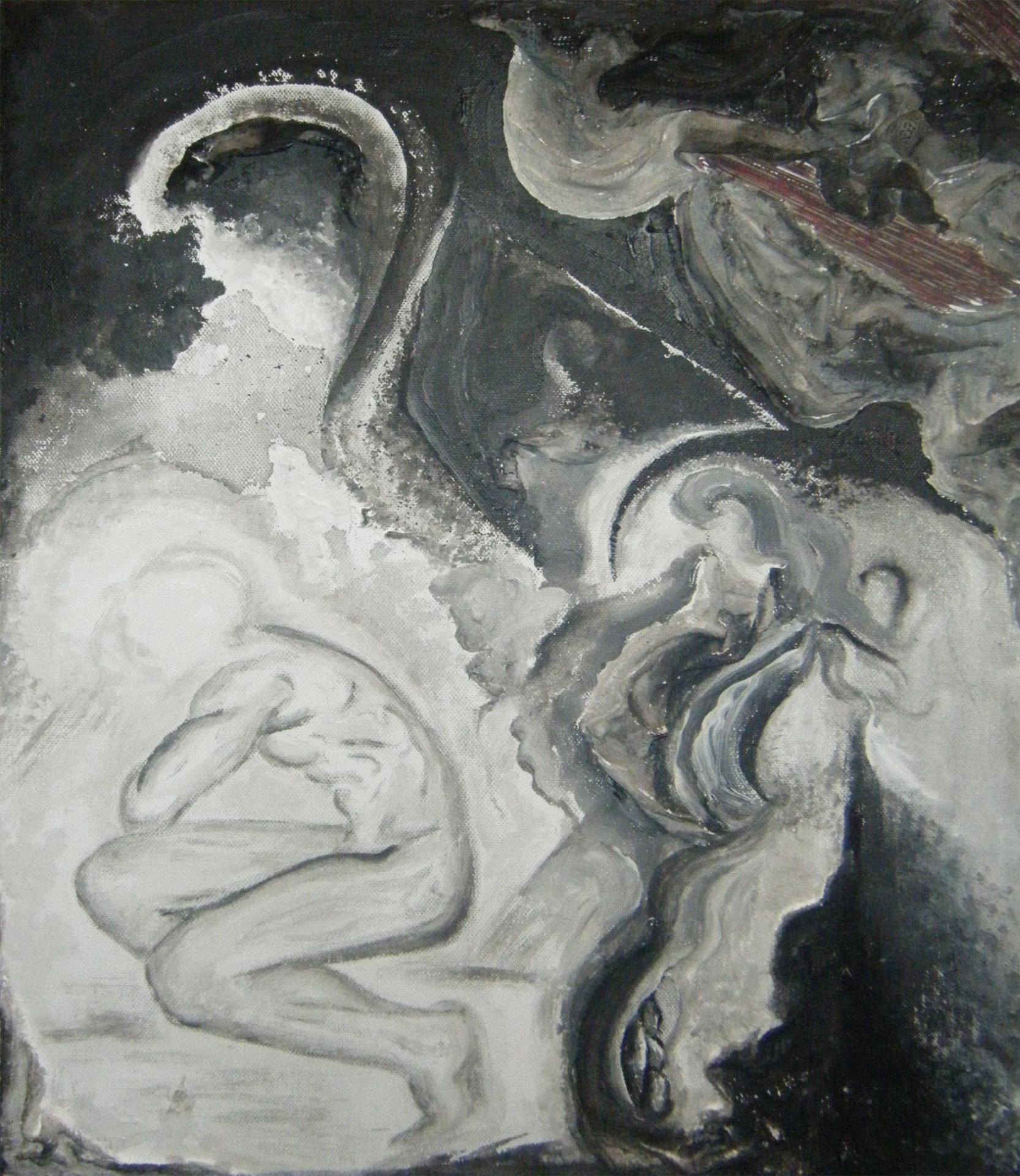Trapped by Disease
This man is the focus and inspiration for my creative piece. His story was told to me entirely by his wife, his main carer. He was diagnosed with Motor Neuron disease following a sudden onset of impaired speech and several episodes of clumsiness more than a decade ago. Over time, his slurred speech has degraded into incomprehensible grunts and airy sighs. He is unable to eat solid foods or drink liquids, and will soon have to obtain all of his nutrients intravenously. He is able to slowly manoeuvre around with a walking device or wheelchair, but otherwise his mobility is considerably limited. He is unable to bath himself, and dressing in the mornings is a strenuous task requiring assistance.
What had the greatest impact on me was that despite these extensive physical boundaries, inside he was alive. He could hear me, could understand me, and could feel emotion. He has thoughts, memories, values, desires and no real way to express them. I use light tones to represent the sense of mental liveliness I felt sitting next to this man. The paler areas of the painting are enveloped and pierced by dark tones in the way I understood his personality to be restrained by his physical state. Abstract shapes of varying darkness, size and texture surround the crouching human figure. The diversity of these figures represents the many different degrees and extents to which this man was trapped by his condition. From his wife’s explanation it was his loss of speech that had affected him most as it put immense strain on his relationship with her, his children and his grandchildren.
It is also significant that the human figure has his back to the drowning dark tones. I gathered a sense of fight left in this man. Although he was left with little physical ability, the disease had not overcome him. There was a life in his eyes and in the small movements he made. He and his wife even exchanged a bit of banter as she revealed his story. This continued willingness to live is represented in the painting by the remnants of light areas amongst the darker sections of the piece.
One of the grim realities of Motor Neuron disease is that it is progressive. Although the progress is slow in this man’s case, he is deteriorating. I found this a particularly difficult fate to grasp and accept as I spoke to his wife. The raised plaster creases that project from the right corner toward the figure represent the fact that his condition will continuously worsen with time. The folds covering the red ridges portray the inevitability that eventually the disease will completely consume this man.
As the home visit came to a close, the man was insistent that his wife showed us photos of his son as a navy cadet and a photo of himself in the Second World War. The man had not forgotten his past, values, or interests. I was touched by his desire to show us these things. These were the things that kept him alive inside. These were the things that Motor Neuron disease could not take away from him.

I love this painting. The artist has brilliantly understood the manifestations of the progressive and visually brought it to life. It captures the true essence of the disease which is symptomatically identified as ‘absence’. The patient would gradually exhibit absence of emotion, physicality, expression and understanding. The darker more abstract areas of the photo depict (from our perspective) the loss of speech which was the biggest affliction of the condition for the patient. But also understanding that there is light, the patient doesn’t allow the disease to overcome him and he still enjoys life to the fullest extent possible. The creases portray the inevitability of the patient’s future which is that the condition will worsen and consume him and his life. Though the light and happiness has not drifted away from him. Very fascinating and inspiring.
This painting hits me on a very personal level. losing one of my close relatives to Motor Neuron Disease makes me appreciate the subtle features of this painting. I still remember how she couldn’t speak to me, or how she couldn’t hug me like she normally does. She used an iPad to type in what she wanted to say. The painting discusses how the patients loss of communication is comparable to being trapped in his own body, and from my own experience; this is very much true. Despite this man illness, he still wants to remember the things most important to him in life, like his son. This is great work.
This is a beautiful piece of artwork, which is very thought provoking. I particularly like the way that the artist has portrayed the subject of the painting as surrounded by an almost halo-like outline of white and I feel this very effectively portrays the retention of an individual’s character and personality whilst battling the gradual progressive loss of movement and independence that is associated with MND. The darker aspects of the picture look, to me, like a heavy, swirling storm, crowding in on the patient, and I think this very effectively portrays the way in which Motor Neurone Disease traps an individual in their own body. The claustrophobic, oppressive and frustrating nature of the disease comes across clearly in the painting, and the darker aspects of the painting appear almost angry to me. This is contrasted vividly with the lighter whites and greys surrounding the man with Motor Neurone Disease, and I especially like the way the artist has portrayed the subject as facing away from the darkness, reflecting that it is his choice to enjoy the rest of time he has, and not to be consumed by the negative aspects of his disease. This piece of artwork emotively represents the dark inevitability of an MND diagnosis, and the ability of the human character to remain bright and positive despite this.